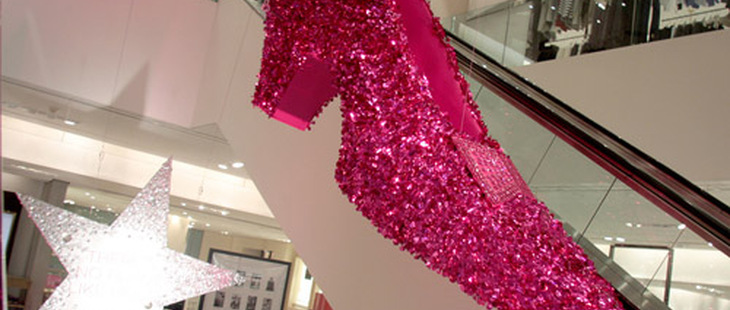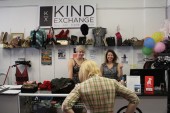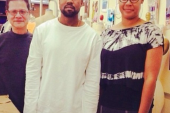
 (Photo: Arianna Perricone)
(Photo: Arianna Perricone)
Holt Renfrew in the summer of 2006 was rife with enchantment. Magenta flags fluttered over Bloor Street as though from turrets. A bouttonired gent bounded out of some beautifully mannered, forgotten time to say hello as though you were somebody. Mannequins tilted sleek heads, lithe saleswomen exhaled perfume over your pulse points. And an escalator whisked you up, way up, into a land of dizzy-high prices and dreams. When you came down again, you still felt lifted.
By you, I mean me. But if you can forgive a little solipsism, I think the fashion scene in Toronto has gone from untested and impressionable to worldly, smarter and competitive in about the same time I’ve been watching it. In five years we’ve seen several designers—Erdem, Jeremy Laing, Rad Hourani, Mark Fast, Mikhael Kale, Calla Haynes, Thomas Tait—win international acclaim. Our own fashion week, while not improving commensurately, has exploded with interested—and interesting—college-age bloggers, photographers and stylists. Post-recession, we’ve hooked American chains (Victoria’s Secret, J. Crew) and department stores (Macy’s and Nordstom’s are scouting locations). Conversely, cool local boutiques proliferate. And if the recent, contemporary-to-high-end retail boom is any sort of proof, well, we’re shopping like we’ve never even heard the r-word.
Until three years ago, you might’ve walked out of Holts and gone to the yupscale enclave TNT, or power-snob shops 119 Corbo and (RIP) Hazel. You could’ve trawled European brand-boutiques like Chanel and Hermes, along Bloor. But those places had opened because Holts was there and they seemed more like a package deal than destinations in themselves.
Now Holts has slick competition for the hearts and wallets of those desirable customers, the trust-fund teens and the 20-something, 30-something, even 40-something child-free working women who spend more than they make. Look around. The Bay, helmed by Bonnie Brooks since August 2008, has undergone a fashion-led transformation that extends from The Room, luxurious crown jewel of the Queen Street flagship, to the splashy introduction of Topshop. The mini-chain TNT (short for The New Trend), with two locations in Toronto, just celebrated its 20th anniversary with an expansion and amalgamation of its Hazelton Lanes stores; now it’s 18,000 square feet of contemporary, mostly womens’, clothing and accoutrements. And two weeks ago, Intermix—a major American boutique-style chain, famed for its high-low shuffle and game-changing e-commerce—opened its first Canadian outpost on Bloor. Though just 2,500 square feet, Intermix manages to pack in and rotate through some 250 labels. Not bad, compared to 300 at the four-times-bigger TNT.
Over the final two weeks of August, I interviewed senior sales and marketing VP Alix Box and fashion direction VP Barbara Atkin of Holt Renfrew; Suzanne Timmins, fashion director at The Bay; Arie Assaraf, founder and owner of TNT; and Khajak Keledjian, Intermix founder and CEO. All agreed that increased fancy-retail competition is good for a city that won’t ever shut up about being world-class. Then, when asked about specific competitors, all more or less said they don’t look at the competition and are only striving to better themselves—which is a lovely sentiment that we can all agree to ignore. Maybe all four will win. But someone’s going to win less.
The first reason to worry about Holts is how bloody optimistic they sound. “Every vendor in the world wants to be at Holts,” says Atkin. “People are happy here,” says Box. “We had a banner year last year, and that makes everyone [who works here] feel great.”
Asked about the 20-some head office members (out of about 200 total) who’ve quit since Mark Derbyshire replaced Caryn Lerner as president in January 2010, and who—according to one marketing staffer who left last year—felt not only not great, but also thoroughly disillusioned as a result of declining corporate culture, creativity and opportunities, Box non-answers by saying the number of employees remains the same. As for why Derbyshire canned the annual gangbusters TIFF party, a decision that whiffs of hard times, Box says it’s because they now do a Variety interview lounge in the store. Customers, it seems, are really into “celebrity-spotting” while they shop.
Such changes are unpalatable not only to ex-employees (and there are three more of those this week, all fired from marketing) but also to Fashion People, which is probably why they work. And they are working. Holt Renfrew reports a surprisingly profitable 2010, their first good year since ’06.
“They did go way up,” says a former Holts PR rep. “But they went up from way down. And they did it by slashing marketing budgets and pouring money on the sales floor. The PR team would promote a great new designer, throw a dinner for them, do a PA [personal in-store appearance]. The very next season that designer—someone like Proenza Schouler, or Kimberly Ovitz—would be dropped because they weren’t selling right away. Instead, they gave stores money to do whatever it takes to sell. Doesn’t matter if it fits the idea of Holts. If a store wants to have a cupcake party, they can have a cupcake party. No one’s going to tell them cupcakes are actually lame.”
I don’t quite understand this, but then, I wouldn’t. Writing about fashion has made me a broke elitist who doesn’t get what most people want from their clothes (e.g. “comfort”). And why appeal to broke elitists who go to the parties and drink the bubbles and might buy one on-sale pair of Miu Mius a season when you can sell to somewhat-moneyed masses seeking beige Michael Kors by the dumpster-load?
So the prices are still high, and most of the brands are still there, but the feeling’s come down significantly. Holts on Bloor is so plastered in magenta branding that the colour looks as cheap as yellow. Saleswomen are dressed like pre-feminism “stewardesses” and have been re-trained to smile, which is a good thing, but also a middle-Canada thing. The bouttoniered, beloved greeter, Tom, has been replaced by door guys with all the panache of mall security guards. And, according to a former personal shopper, “[Derbyshire] strolls around the floor wearing the same $49.99 blue shirt every day.”
Holts has bought few new lines this season, and most have more Us Weekly appeal (Lily Allen, Rachel Zoe) than fashion cred. The major exception is Tom Ford’s womenswear line: a throwback to unadulterated luxury, old-world craftsmanship, and old Holts. Two months ago I interviewed Atkin about Ford for a FASHION Magazine feature. She gushed that he’d brought back “exclusivity in fashion.”
When I interviewed her for this story, she said dismissively that “exclusivity” was “an old word.”
Which is why it’s strange how “there’s no place like Holts” is the company’s new party line. Versus the rest of this year’s sublimely tacky slogans—including spring’s “you can’t live without” (to which the only true answer is “a coat in winter”) and this season’s straight lie “everyone’s a star!”—I like it. Then again, maybe that’s ’cause I wrote it. For a year and a half, off and on, I wrote copy for a design agency that handles Holt Renfrew’s printed matters. My first ad idea was so obvious I couldn’t believe it had never been used: “there’s no place like Holts” spelled out over a surrealish illustration in which products drifted on melting clouds and red-soled Louboutins stood in for Dorothy’s slippers. Yeah, didn’t fly. Now, according to the blue-shirted Derbyshire’s letter in Holts’ Fall ’11 catalogue, a customer fed him the winning line. “I loved her expression so much,” he writes, “that we’ve woven it into the very fabric of our organization.”
I don’t believe this any more than I believed I was the first person to utter the phrase, but that doesn’t make it untrue. No, it’s untrue because no matter what Box tells me about the “unique and extraordinary in-store experience,” Holt Renfrew is making money like the opposite of unique and extraordinary: a big-box chain store. Products—a Marc Jacobs tote bag for a charity, a new perfume, a loafer-pump—are the stars, not great designers or even trends (despite Atkin’s own highly respected sense for both). Their once-mighty bi-annual magazine, with fashion modelled in far-flung locations, is now a six-times-a-year catalogue, shot in-studio. It used to reach 50,000 of the quote-unquote right people; now it’s sent to 500,000 people, like a Sears catalogue. In terms not of what they’re selling, but how they’re selling it, there are places like Holts in plazas everywhere.
Where Holts Renfrew has gone down, the Hudson’s Bay Company has come up. The former is a nine-location fashion department store that’s gone mass; the latter, a 62-location mass department store attempting to go fashion. Suzanne Timmins has been with The Bay since 2002, while most of the top buyers and fashion marketing people were hired post-Brooks. She’s friends with Atkin, but says they don’t talk work. With me she uses fewer industry shibboleths, like “trending” and “relevant” and “in-store experiences,” than Holts honchos. Instead of referring to customers as “the customer,” the way fashion editors call pants “a pant,” she calls them “people.”
And Timmins seems transparent, almost realistic. (Discussing The Bay’s big-selling, less-fashion brands, she wonders out loud how Jessica Simpson’s line got so huge: “It can’t be all her—it’s like, huh?”)
“The first year at The Room was hard for us,” Timmins says. “Opening in October [2009], in a recession, oh my god.” She acknowledges the casual impression that all The Room’s beautiful, crazy-expensive, even avant-garde garments—Erdem, Giles, Proenza Schouler, Junya Watanabe, Mary Katrantzou—can’t be selling well enough to keep the 25,000-square foot space afloat. I ask, having heard rumours of profligate budgets to begin with, if The Room is in a honeymoon phase. “Look, it’s been almost three years,” she says. “If it was an experiment gone bad, we wouldn’t be opening another one in Vancouver.”
With endless flossy parties, a youth-baiting online magazine (to which—disclosure—I sometimes contribute), international press outreach, social media and the prowess of charming, shrewd buyer Nicholas Mellamphy, The Room in Toronto has made its mark aggressively. Too aggressively? “It’s overkill,” says Anita Clarke, the popular and opinionated fashion blogger. “I hate using that word, but I’ve skipped the last few parties, because it’s more of the same. They’re blanketing the scene.”
Blanketing it in iconic stripes, at least. The Bay has successfully co-branded itself with Old Canada, turning their 221-year-old wool blanket into an internationally recognized statement piece. When Tony Smith was hired as The Bay’s creative director in 2010, he half-kiddingly told me it was like “being creative director of Canada.” And yet The Bay is no longer Canadian-owned, having been bought by Lord & Taylor (a traditional department store, which, not immaterially, figured as the dying symbol for all other traditional department stores in an elegiac 2003 New Yorker piece. Holts may have missed a chance to align itself with national heritage, nostalgia and pride, things that could be handy as American fashion forces invade.
What Holts does have in the way of tradition—and what The Bay, with its lower floors of cheap wears and boring domestic stuff, may never achieve—is the whole day immersive shopping experience. Twin-like mothers and daughters can get pedicures, quinoa salads, hundred-dollar candles and dresses made for liquid dinners in one great big place. “That’s definitely me and my mom,” laughs Christina Sutherland, 26, a Rotman MBA student and serious shopper. “We have relationships at Holts, and it’s reliable. If I’m going out with my girlfriends, I’ll get a dress at The Room. But if it’s me and my mom going to a wedding, we’ll go to Holts. We always find something. And if we didn’t, we’d go to TNT.”
That’s been the order of things for many shoppers, but touring the newly expansive TNT space with owner Assaraf, I wonder if the script won’t flip. Not unlike Holts, TNT has a tween-to-mom range of contemporary fashion, from Free City t-shirts to $5,000 fur coats with lots of Theory and Acne and Smythe and Greta Constantine in between. There are some surprisingly forward pieces, too, like a $1,500 Comme des Garons black transparent thing that might be a dress.
Assaraf wears a hefty, “secret” blend of CDG and Monocle perfumes, greets sales staff and faithful shoppers by name, and never ever tires of talking. If I had a dollar for each time he said “we’re taking it to another level,” I could buy that black transparent thing. (And would.) The only time he’s stymied for words is when I ask him whether TNT was profitable last year.
Assaraf: “Every year is profitable.”
Me: “Every year? Even the first year? How?”
Assaraf: “Well, what do you mean by profitable?”
Me: “I mean, you make more money than you spend.”
Assaraf: “I don’t think about it like that. I think about growing.”
By next summer, Assaraf will have two new spaces next to his current Eglinton location—one for shoes, one for resort and vacation wear—bringing his total Toronto retail space to 24,000 square feet, rivalling The Room and White Space. And, perhaps most importantly, he’ll make Holt Renfrew the only major Toronto fashion destination to not sell online.
Intermix just opened, but it’s not a new threat. Canadians have been shopping Intermix online for a decade. When Khajak Keledjian visited Toronto earlier this summer, he told me he set up shop here in large part because we make up about 30 percent of his e-business.
Assaraf says he’s not worried about Intermix. “I met Khajak at Market Week in New York,” he tells me, “and—you can quote this—he told me he was a gentleman. Because I gave him advice, you know, about duties and things like that. I welcome him.” (I mention this to Keledjian the morning Intermix opens, but his response is blank consent.) Friendliness aside, though, Intermix is here to remind Toronto retail how badly we need e-commerce. The Bay has just begun, putting their exclusive Erdem collab online. By spring, Timmins says, they hope to have all apparel—from Topshop to The Room—for e-sale.
“It’s ridiculous that The Bay is doing it and Holts isn’t,” says the blogger Clarke, herself a loyal Holts customer. Sutherland agrees. “I think if you want to be in the game, the game’s e-commerce,” she says. “People spend countless hours at their desks. If you have ten minutes on a lunch break, you’re going online, not to the store. And if you can see what Holts and TNT and The Bay have to offer, if you can compare online, when you do have a whole day to shop you’ll have decided where to go based on that.”
E-commerce will be a boon, especially, to the Bay’s White Space, contemporary kid sister to The Room and potentially the bigger moneymaker. (Profit margins are typically highest in the bridge bracket of fashion.) They have some catching up to do: Holts, TNT and Intermix were all founded in the early ’90s. My friends who like Suno and Opening Ceremony and MM6 by Margiela don’t know you can buy a small-but-decent selection there. With an e-store, that key working girl demographic might get clued.
Meanwhile, with a retrograde department-store model and without e-commerce, will Holt Renfrew survive in an increasingly globalized and specialized retail age?
“It’s less a question of ‘survival’ and more a question of missing a big opportunity,” says Imran Ahmed, the Business of Fashion blogger and consultant. “American department stores like Neiman Marcus and Nordstrom have shown that these can be built into substantial businesses, helping drive traffic to bricks-and-mortar stores. Luxury retail is a big opportunity that has not been tapped in Canada.”
Holt Renfrew, of course, hasn’t said they’ll never do e-commerce; just not now. From where I stand, it’s another sign they’ve lost their fashion-forward momentum, content instead to make money in the middle. Perhaps they know their relatively conservative buy—more than one designer I know has made the joke that if you sell it to Holts, you better make it in black—won’t fly on the trend-whoring internet. Or maybe, as they say, they’re truly focusing on that hallowed “in-store experience.”
One day I go to try again for that experience (as opposed to almost every other time I go, for events). It’s bright. It’s pretty busy. There’s an enormous glitterbomb of a magenta shoe hanging between the escalators I once thought led to dreams. It’s overwhelmingly American mall-tacky. But would I always have thought so? There are teen girls on their lunch breaks, giggling and whispering; they looked thralled enough. Maybe Holts hasn’t changed so much. It’s only that we have.
__
Sarah Nicole Prickett is Toronto Standard’s Style Critic.














